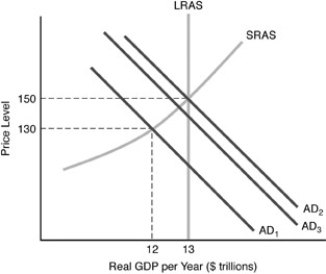
-Refer to the above figure. Suppose that the economy initially is operating along AD1. If the government seeks to close the recessionary gap by raising government spending without any change in taxation, which moves the aggregate demand curve from  to
to  , then to
, then to  . Which of the following scenarios is true?
. Which of the following scenarios is true?
A) Interest rates fall and investment rises.
B) Both interest rates and investment fall.
C) Both interest rates and investment rise.
D) Interest rates rise and investment falls.
Correct Answer:
Verified
Q141: If the federal government borrows from the
Q142: Supply-side economists argue cuts in tax rates
A)always
Q143: When private expenditures decrease as a result
Q146: According to the Laffer curve, we know
Q153: The theory that government borrowing may function
Unlock this Answer For Free Now!
View this answer and more for free by performing one of the following actions

Scan the QR code to install the App and get 2 free unlocks

Unlock quizzes for free by uploading documents